Back to the Annual Report Contents and Home page
Winter Watch
by Janet and Tom Denney
Snow first fell on 17 December and remained until 17 January, with further snowfalls during that time. The amount was difficult to measure as the snow was often powdery and so drifted. During this period melt water in our rain gauge measured 150mm which probably equates to about 60cm of snow. Temperatures remained around -5°C for much of the time, but Adrian Smith has more accurate records elsewhere in this report.
Before the snow, large parties of northern thrushes (fieldfares and redwings, or Scandahooligans as Tom calls them) were feasting on hips, haws, holly and rowan berries which were very plentiful this autumn. After the snow came the northern thrushes disappeared, although mistle thrushes and blackbirds stayed with us. A large flock of fieldfares is now back feeding on nearby fields and we wonder where they were feeding during the spell when much of Britain was covered by snow.
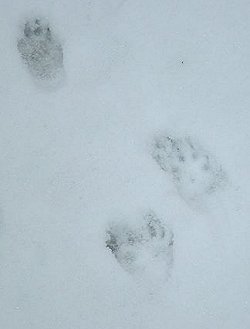 Prints in the snow revealed we had a stoat in the garden which we eventually saw, though sadly not ‘in ermine’. One of the reasons for the stoat’s visits proved to be free food we inadvertently provided – a couple of brace of pheasant were hanging in our woodshed and when brought inside to prepare, one of the birds felt surprisingly light and we found the breast had been partly eaten. The footprints in the snow below where the pheasants had hung proved our friend the stoat was the guilty party. (Click on the photo for a larger version.)
Prints in the snow revealed we had a stoat in the garden which we eventually saw, though sadly not ‘in ermine’. One of the reasons for the stoat’s visits proved to be free food we inadvertently provided – a couple of brace of pheasant were hanging in our woodshed and when brought inside to prepare, one of the birds felt surprisingly light and we found the breast had been partly eaten. The footprints in the snow below where the pheasants had hung proved our friend the stoat was the guilty party. (Click on the photo for a larger version.)
Bark has been eaten on a number of mature rowans, though young saplings in our intake have not been touched. Footprints in the snow confirm rabbits are the culprits. Logs on our winter woodpile have come complete with fungi (see pictures below). The russet coloured fungus growing on Scots pine is as yet unidentified** and the larger, growing on rowan, is probably an oyster mushroom Pleurotus pulmonarius – note the stout and woolly base of the stems – (identification thanks to Rhona Sutherland).
**[Ed: I have since had a note from Gordon Simpson: “The unknown fungus ... is Tremella foliacea. It is parasitic on the mycelium of Stereum species, in this case it will most likely be on Stereum sanguinolentum.” Fascinating – this fungus is parasitic on another one, not directly on hte dead wood! Thank you, Gordon.]
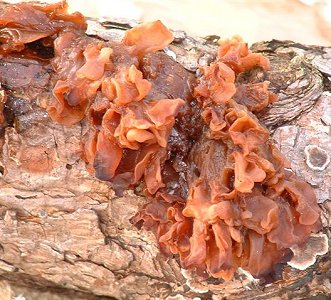
Unknown fungus on Scots pine |
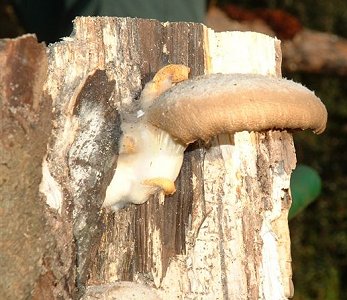
Oyster mushroom on rowan |
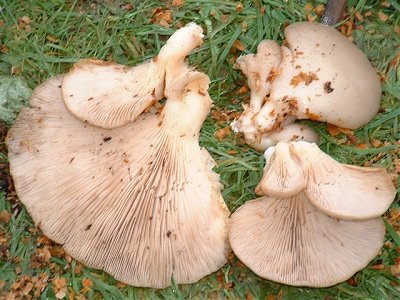
Oyster mushroom from rowan |
When the snow melted it revealed there had been much hidden activity on our lawn where there were several patches of tunnels on the surface (see below). Michael Thompson confirmed this is typical of field voles (Microtus agrestis). On further reading about voles we learn they also eat bark although none of the trees in the garden appear to have been eaten (as yet!)
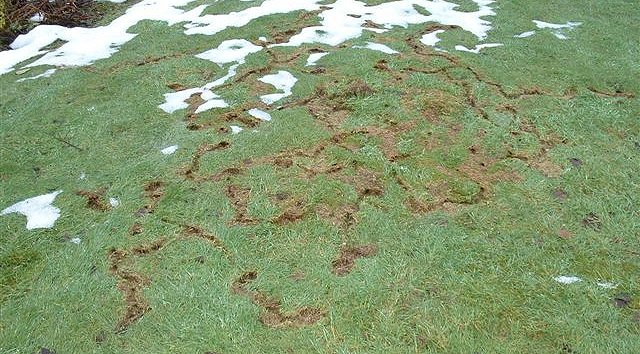
Field vole runs emerging under the snow |
Moles have also been exceedingly busy under the snow, but now it has melted we can see that some of the hills are smaller and much closer together and the tunnelling nearer to the surface than normal. We conjecture that the insulating cover of snow brings worms up near the surface and the moles follow.
The bird feeders have been visited regularly by large parties of chaffinches, a party of 5 tree sparrows, and 8 blue tits. We like to think these 8 blue tits could be the parents and 6 offspring we watched last summer in our box fitted with a camera. The 8 tits certainly have the appearance of a family party and we feel a somewhat fanciful attachment as we have known the young since they were eggs! Brambling, siskin, greenfinch and goldfinch have only appeared in singles so far this year.
We are writing this in early February so it is possible we may have more snow before winter finally goes but snowdrops are showing, a greater spotted woodpecker is drumming in an old sycamore and great tits are beginning to sing. A pair of robins, a pair of dunnocks and a pair of house sparrows are often in the garden, and tree sparrows are in and out of one of the nest boxes. Could it be Spring is in the air?
 Prints in the snow revealed we had a stoat in the garden which we eventually saw, though sadly not ‘in ermine’. One of the reasons for the stoat’s visits proved to be free food we inadvertently provided – a couple of brace of pheasant were hanging in our woodshed and when brought inside to prepare, one of the birds felt surprisingly light and we found the breast had been partly eaten. The footprints in the snow below where the pheasants had hung proved our friend the stoat was the guilty party. (Click on the photo for a larger version.)
Prints in the snow revealed we had a stoat in the garden which we eventually saw, though sadly not ‘in ermine’. One of the reasons for the stoat’s visits proved to be free food we inadvertently provided – a couple of brace of pheasant were hanging in our woodshed and when brought inside to prepare, one of the birds felt surprisingly light and we found the breast had been partly eaten. The footprints in the snow below where the pheasants had hung proved our friend the stoat was the guilty party. (Click on the photo for a larger version.)


